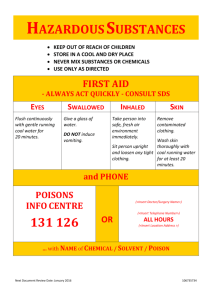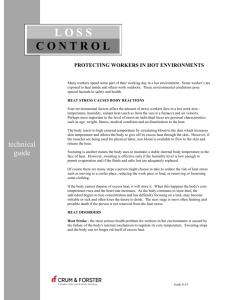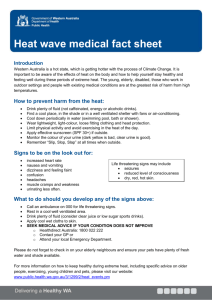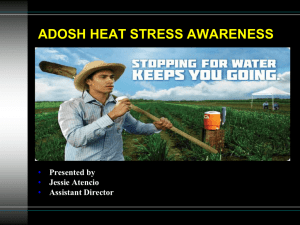Ergonomics
advertisement
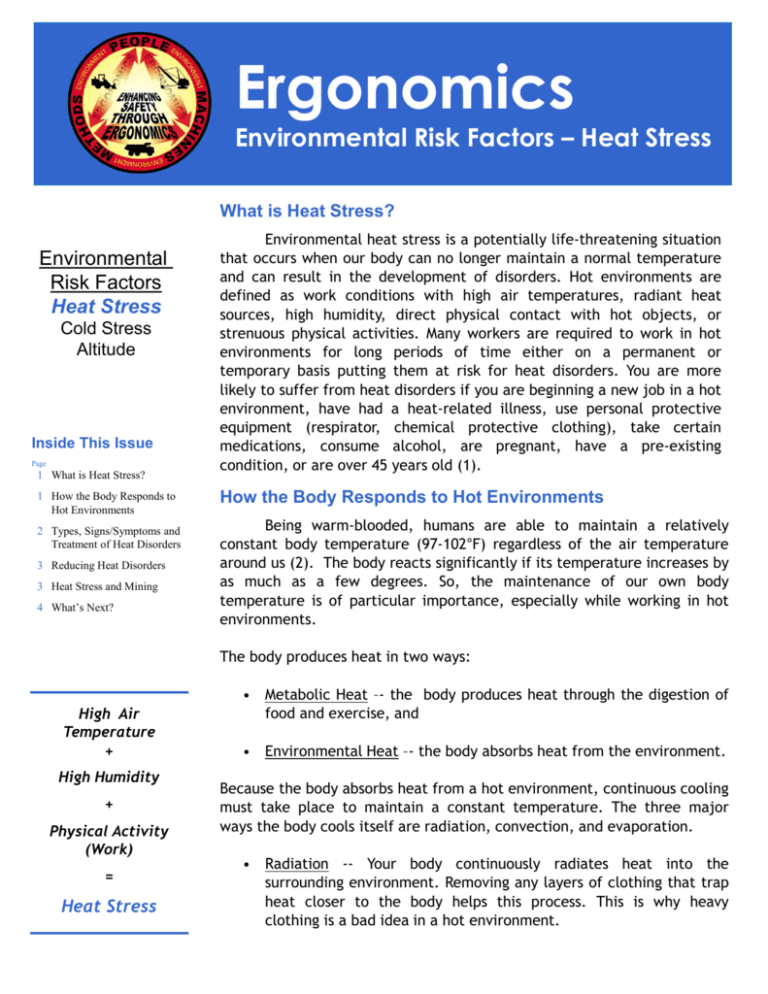
Ergonomics Environmental Risk Factors – Heat Stress What is Heat Stress? Environmental Risk Factors Heat Stress Cold Stress Altitude Inside This Issue Page 1 What is Heat Stress? 1 How the Body Responds to Hot Environments 2 Types, Signs/Symptoms and Treatment of Heat Disorders 3 Reducing Heat Disorders 3 Heat Stress and Mining 4 What’s Next? Environmental heat stress is a potentially life-threatening situation that occurs when our body can no longer maintain a normal temperature and can result in the development of disorders. Hot environments are defined as work conditions with high air temperatures, radiant heat sources, high humidity, direct physical contact with hot objects, or strenuous physical activities. Many workers are required to work in hot environments for long periods of time either on a permanent or temporary basis putting them at risk for heat disorders. You are more likely to suffer from heat disorders if you are beginning a new job in a hot environment, have had a heat-related illness, use personal protective equipment (respirator, chemical protective clothing), take certain medications, consume alcohol, are pregnant, have a pre-existing condition, or are over 45 years old (1). How the Body Responds to Hot Environments Being warm-blooded, humans are able to maintain a relatively constant body temperature (97-102°F) regardless of the air temperature around us (2). The body reacts significantly if its temperature increases by as much as a few degrees. So, the maintenance of our own body temperature is of particular importance, especially while working in hot environments. The body produces heat in two ways: High Air Temperature + High Humidity + Physical Activity (Work) = Heat Stress • Metabolic Heat –- the body produces heat through the digestion of food and exercise, and • Environmental Heat –- the body absorbs heat from the environment. Because the body absorbs heat from a hot environment, continuous cooling must take place to maintain a constant temperature. The three major ways the body cools itself are radiation, convection, and evaporation. • Radiation -- Your body continuously radiates heat into the surrounding environment. Removing any layers of clothing that trap heat closer to the body helps this process. This is why heavy clothing is a bad idea in a hot environment. Page 2 Environmental Risk Factors – Heat Stress How the Body Responds to Hot Environments Cont. Image from (3) • Convection -- Convection occurs when heat is transferred away from your body by moving air. An example would be placing a fan in your work area. • Evaporation –- Evaporation is the process of changing a liquid to a vapor. This process requires energy. When your sweat evaporates, energy is drawn from the body in the form of heat and as heat is releases, the body cools. Image from (4) Types, Signs/Symptoms and Treatment of Heat Disorders When a worker’s body is not able to maintain a normal temperature in a hot environment, heat stress related illnesses can occur and may be life-threatening. Below is a table explaining the types, signs/symptoms and treatment of heat related disorders (1, 5). Types Signs/Symptoms Treatment Takes place when workers have not acclimated to the environment or physical demands. •Decrease in performance •Lack of good judgment •Increase water/electrolyte intake •Rest in shade/cool environment Heat Rash Appears when the skin starts to waste away because sweat cannot evaporate from the skin. •Red blisters (neck, upper chest, groin, under breasts and in elbow creases) •Loosen clothing •Dry skin often •Use drying powders Heat Collapse Occurs when the blood pools in the extremities instead of returning to the heart. •Fainting •Reduced movement •Rest in shade/cool environment •Wait for normal color to return to victim’s face Heat Cramps Caused by too many or too few electrolytes. Affects people who sweat a lot. •Painful muscle spasms (abdomen, arms, legs, back) •Heavy sweating •Increase water/electrolyte intake •Rest in shade/cool environment Heat Exhaustion Happens when workers fail to replenish water and electrolytes lost during sweating. •Pale and clammy skin •Headache •Weakness, fatigue •Nausea •Normal body temperature •Dizziness •Heavy sweating •Lie down in cool environment •Increase water/electrolyte intake •Loosen clothing •Call ambulance once in shade/cool environment. Heat Stroke Life threatening. Arises when the body loses the ability to sweat causing body temperature to rise. •Cessation of sweating •Skin hot and dry •High body temperature •Unconsciousness •Collapse •Convulsions •Confusion or erratic behavior •Rapid pulse •Medical Emergency – Call ambulance •Move victim to shade/cool environment •Cool the victim by any means (loosen clothing, spray with water, immerse in cold water while massaging skin) Heat Fatigue Page 3 Environmental Risk Factors – Heat Stress Reducing Heat Disorders Knowing the signs and symptoms of heat stress and how to respond, you can take steps to reduce your chances of developing injuries or illnesses related to heat stress -– hydrate, assess conditions and risks, and acclimate to conditions (6). Image from (7) Hydrate Assess Conditions and Risks Hydrate -- Hydration is the most important step to combating heat stress. In addition to coming to work well hydrated, workers should drink one cup (8 oz) of water every 15 to 20 minutes (5). Workers should not wait until they feel thirsty to drink. If a worker is already thirsty, they may have already lost 2% of their body’s water. The onset of heat exhaustion can begin after losing 3% of the body’s water and heat stroke occurs once 8% is lost (6). Assess -- Assess the relative danger of the conditions and your personal risk factors. Image from (8) • Conditions: The heaviest work should be performed during the coolest part of the day because high heat, high humidity and physical activity all create a more dangerous working environment. Any time more than one of these variables is present, the danger is greatly increased. In these conditions, workers need to take frequent breaks in shaded or air-conditioned areas to allow the body to cool down and wear light, loose-fitting, breathable clothing. Acclimate to Conditions Exposure (New Worker) Exposure (Returning Worker) 1 50% 50% 2 60% 60% 3 70% 90% 4 80% 100% 5 90% 6 100% Chart adapted from (5) Day • Personal Risks: Each worker must assess their own personal risk. This is the risk that makes them more susceptible to heat stress such as poor physical conditioning, previous heat-related illnesses, chronic diseases, recreational drugs, alcohol, caffeine, and some medications. Acclimate – If a worker is new to a job, it is important to ease them into full-time work over the course of several days. Starting at 50% exposure and increasing to 100% exposure by 10% each day can greatly reduce the worker’s susceptibility to heat stress. It is also important to realize that workers who are already acclimatized who return to work after nine or more consecutive days away from work should be acclimated using a similar, but less gradual, schedule (5). Image from (5) Heat Stress and Mining Surface and underground mines can be hot work environments that increase a workers risk of heat stress. Mine planning, ventilation and air conditioning help reduce heat stress, but it may not be completely eliminated. The table on the next page lists some common heat sources and controls found in surface and underground mines (9). Page 4 Environmental Risk Factors – Heat Stress Heat Stress and Mining Cont. Surface Mines Heat Source Control Sun Heat from the sun can be controlled by using canopies in most cases. Machines, dryers, kilns Heat from machines, dryers and kilns can be controlled by shielding. Underground Mines Heat Source Control Wall-rock Heat from wall-rock can be controlled through ventilation. Sometimes air conditioning is necessary. Powered equipmentdiesel engines, electric motors, compressed air equipment Heat can be controlled through use of more efficient equipment and providing ventilation in the mine. Ground water Heat/humidity transfer from the ground water to the underground mine air can be controlled by using covered ditches or insulated piping when transferring hot water to the surface. Blasting 50 to 100 percent of the energy set free in blasting shows up in the form of heat. Effective blasting procedures such as increasing ventilation and blasting during off-shifts will reduce the amount of heat that is released in the mine and the heat exposure to the miners. In addition to the types of heat stress discussed earlier, a worker attempting to do his job in conditions conducive to heat stress is simply not physically able to perform at optimum efficiency as seen in the graph to the right. Under heat stress, a worker will begin to feel tired and will have difficulty concentrating and staying on task. In addition, the poor judgment that comes with heat stress causes an increase of accidents that could have been avoided. What’s Next Effects of ambient temperature on work output when loading cars and drilling rock (10) The next newsletter will discuss the environmental risk factor of cold stress. Cold stress is a very serious condition that occurs when the body can no longer maintain a normal temperature in a cold environment. The results can be serious cold-related illnesses and injuries, permanent tissue damage or death. References: 1. 2. 3. 4. 5. 6. 7. 8. 9. 10. Mine Safety and Health Administration (2001). Heat Stress in Mining. United States Department of Labor. Safety Manual No. 6. American Industrial Hygiene Association (1975). Heating and Cooling for Man in Industry (2nd Edition, page 5). United States Department of Agriculture (2011). Hydration Strategies for Firefighters. [http://www.fs.fed.us/eng/pubs/htmlpubs/htm08512324/]. Date accessed: March 2011. National Ag Safety Database (2011). Heat Stress. [http://nasdonline.org/document/137/d001702/heat-stress.html]. Date accessed: March 2011. National Institute for Occupational Safety and Health (2011). Heat Stress. [http://www.cdc.gov/niosh/topics/heatstress/]. Date accessed: March 2011. Pacific Northwest Agricultural Safety and Health Center (2011). Heat Illness Know the Facts. [http://depts.washington.edu/pnash/heat_illness.php]. Date accessed: March 2011. Workplace Safety Experts (2011). Heat Stress Safety Tips. [http://workplacesafetyexperts.com/workplace-safety-tips/heat-stress-safety-tips/]. Date accessed: March 2011. Electronic Library of Construction Occupational Safety and Heath (2011). Roadway Safety: Working Outdoors. [http://www.elcosh.org/en/document/670/d000633/roadway-safety%253A-working-outdoors.html]. Date accessed: March 2011. Mine Safety and Health Administration (2011). Heat Stress in Mining. [http://www.msha.gov/s&hinfo/heatstress/manual/heatmanual.htm]. Date accessed: March 2011. Misagi, FL. (1977) Heat Stress in Mining. Mining Enforcement and Safety Administration Safety Manual Number 6. Authors: Michelle Reiher (mreiher@mines.edu) and Janet Torma-Krajewski (jtorma@mines.edu)
